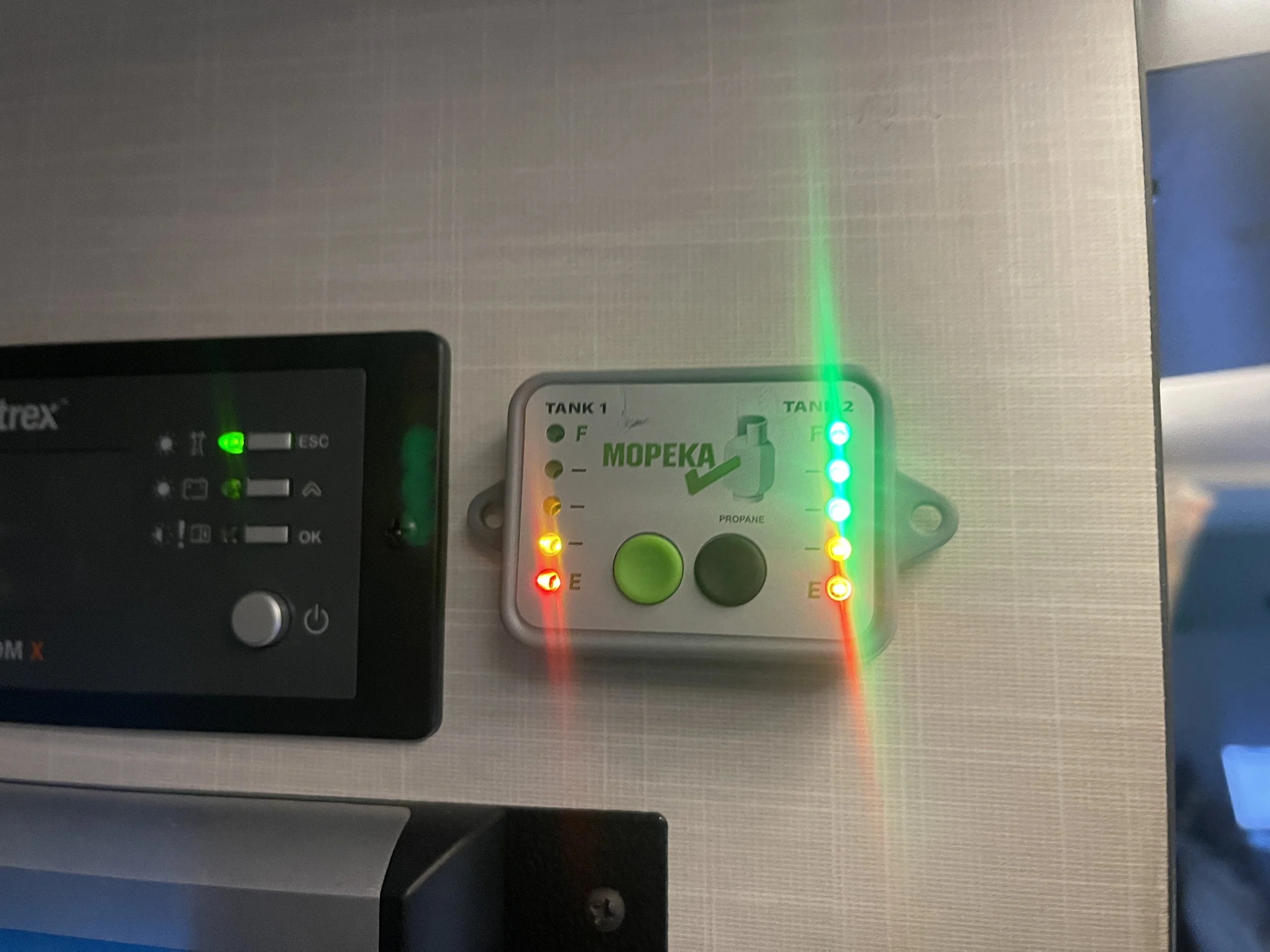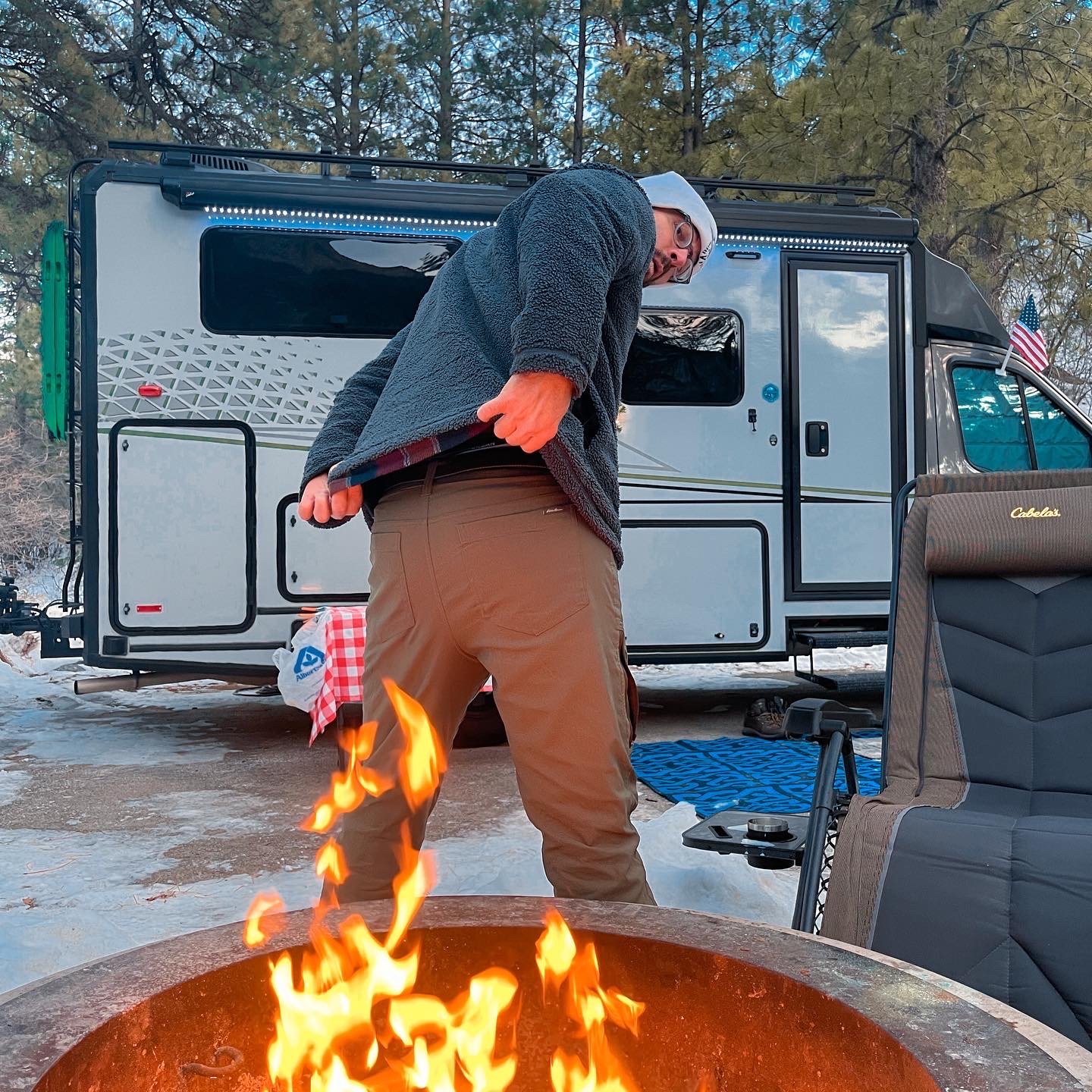12 Best Winter RV Camping Tips That Will Keep You Warm and Safe
When winter is coming, for many RVers it’s time to winterize the RV and store it for the winter months. For us, winter means winter camping and taking our small RV up into the mountains and rv camping in the snow. RV camping is something that we really enjoy – we enjoy getting away from it all snow shoeing, sledding, hot tent camping, among other fun winter activities.
Understanding the winter capabilities of your RV
Preparing your camper van for winter RV life however can be a challenge and will vary depending on your rig. We have been living in our Winnebago Ekko for over a year now and spent a lot of time RV camping in the snow and cold weather. Well, winter is coming again and it’s time to get our RV ready for winter camping. While our Winnebago Ekko has advantages over many other rigs for winter camping, which we will explain in this blog, we will also discuss and contrast winter rv camping challenges that can apply to any RVer.
Does your RV need a skirt?
We have taken our van into low single digit temperatures, while maintaining water in all of our tanks. Not all rigs can do this. Fortunately, the roof, walls and floor of the Winnebago Ekko are all insulated with thick all-weather insulation and all the water tanks are behind this insulation. Consequently, there is no need for us to winterize our rig so long as we are going to be living in our RV. Also, we don’t need to apply a skirt around our RV as many others will do to help maintain temperature in the rig and prevent the tanks from freezing.
Watch out for your RV windows
The Winnebago Ekko also has dual-paned acrylic windows which do a great job keeping the heat in during those cold winter days and nights. Without the dual-paned windows, many RVers would need to consider covering their windows completely with insulated panels – effectively blocking out much of the natural light from the RV.
No need to freeze those tank hoses
In most RVs, the black tank and hoses can be a real challenge to keep from freezing in the cold winter. Your lines could freeze up creating so-called poop lollipops, ouch, especially if you leave the black tank hose connected – which we would never recommend in the winter cold. In our case, our campervan uses a cassette toilet and the cassette is held within the heated compartment space. No concerns for freezing. Plus, we don’t run any sewer hoses to our cassette, instead just open the outside compartment for the cassette toiler when we need to empty it.
Fill up fresh water tanks
During the winter months, we typically boondock when we camp in our RV. One reason for this is because many RV parks and campgrounds with connections are closed where we often winter camp. Even if the campground is open, the fresh water spigots may also be turned off. Consequently, we always make sure that we fill up our fresh water tank before we head off into the cold snowy mountains.
A quick winter RV camping tip is to not leave your water line connected to a water spigot during the cold winter nights, unless you have a high degree of confidence in your insulated lines and connections.
Keep track of the temperatures in your water compartments & tanks
During our first winter in our Winnebago Ekko, we were concerned about the temperatures in our outside compartments, especially the water controls compartment. Because of this, we purchased a few Temp Sticks that allow us to monitor the temperature in the outside compartments and keep track of the temperature remotely via Wifi. We were very pleased with the performance of the Ekko’s compartments after testing them down into the low single digits. The heated and insulated compartments, including the water controls compartment, always stayed at temperatures comfortably above freezing.
Keep your rig’s heat running
One thing that is very important is to make sure we keep our van’s heat on during the winter months so that both the rig and the compartments stay warm and above freezing. We do have a space heater as well that we use sometimes in the Ekko, but we never want to rely exclusively in the rig. If the heat from the space heater doesn’t reach the areas behind the walls on very cold nights, we are concerned that the compartment and tanks could be at risk of dropping below freezing.
Know how long your rig’s heat will last in extreme cold
Our van uses a Truma AquaGo water heater and Truma Vario heater both of which run off propane. Before depart on a winter camping trip, we make sure to fill up our two 20 pound propane tanks. Fortunately, our Truma heaters are incredibly efficient and we have been impressed with how long our propane lasts while out winter rv camping. As an example, last winter we ran our Truma Vario heater overnight for 8 nights in temperatures of around 15 degrees at night. After 8 nights we had only used three quarters of just one of our tanks while the other propane tank remained full. We used Mopeka propane tank monitors to help us keep track of our propane levels.
Limit propane use if need it for RV’s heat & hot water
We use the Mopeka Propane Tank Monitoring System
Another way we reduce our propane use during the winter months is to use a portable induction cooktop, versus our propane stove-top burners in our rig. Another tip to reduce propane use is to run the Truma Aqua in Eco mode versus Comfort mode. While the water in Eco mode may not get hot quite as quickly as when in Comfort mode, we found Eco mode to perform very well overall heating up our hot water.
Don’t drive with propane and heat on even in winter months
We have also added the Truma AquaGo Electric anti-freeze kit. This allows us to drive in temperatures well below freezing without risk of the AquaGo freezing, even when the propane and water heater is off. We do not recommend driving with your propane on and this kit allows us to shut off our propane while driving in extreme cold temperatures without freezing risk.
Manage condensation in your RV
Condensation is a big issue in RV’s, especially during winter camping. We have had condensation issues in our Winnebago Ekko as well. When the nights are really cold and our heater is keeping us warm and cozy inside, condensation can sometimes build up on the walls and ceiling of our bedroom area when we sleep. To help address this, we have a small portable dehumidifier and we also will often slightly crack open our Max Air fan to allow the more humid air to escape through the roof.
Make sure you have good winter snow tires
To help us with winter traction, not only is our rig AWD but we also upgraded the tires from the standard stock tires to larger Falkens, which are excellent in the snow. In addition, we added a QLift life creating about 2” of additional clearance.
Invest in efficient and easy camp fire pits
We all enjoy gathering around campfires. Winter campfires in the snow are even more special. To help our campfires burn more efficiently, we have a Solo Ranger Stove, which does a great job helping us lengthen the burn time of our wood. In addition, we also have a propane fire pit with quick propane connect that we use sometimes as well. It’s a quick and easy way to enjoy a warm campfire – just be cautious not to drain your propane too much if you need your propane for your rig’s heat!
Winter RV camping can be a lot of fun with some preparation and understanding the capabilities of your rig. There is no need to be afraid of winter RV camping – so get out there and enjoy the snow! Have anything winter camping questions leave them in the comments below. We’d be happy to help.m







